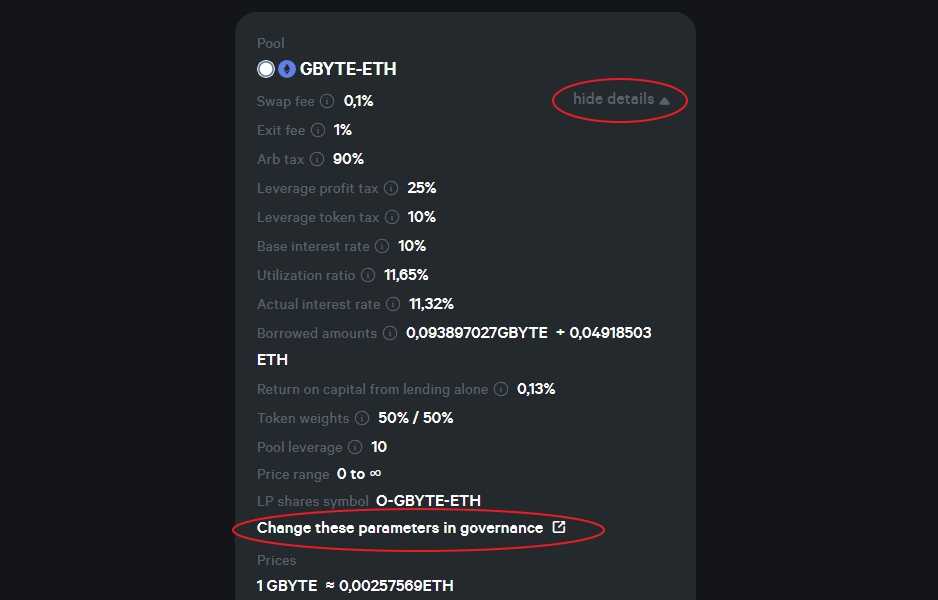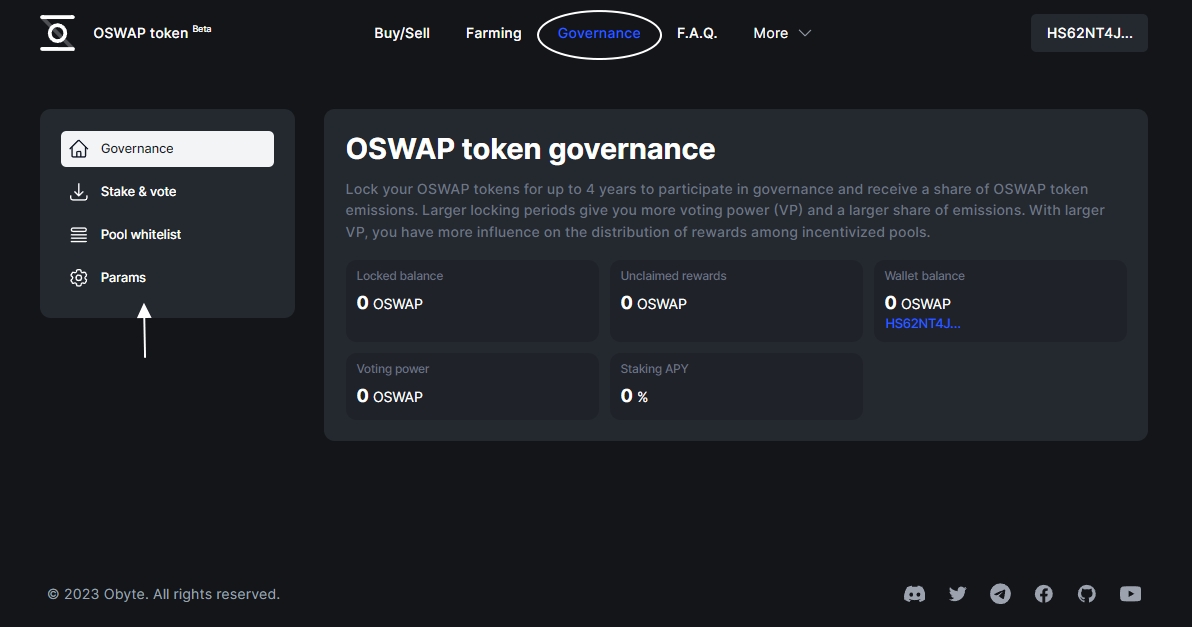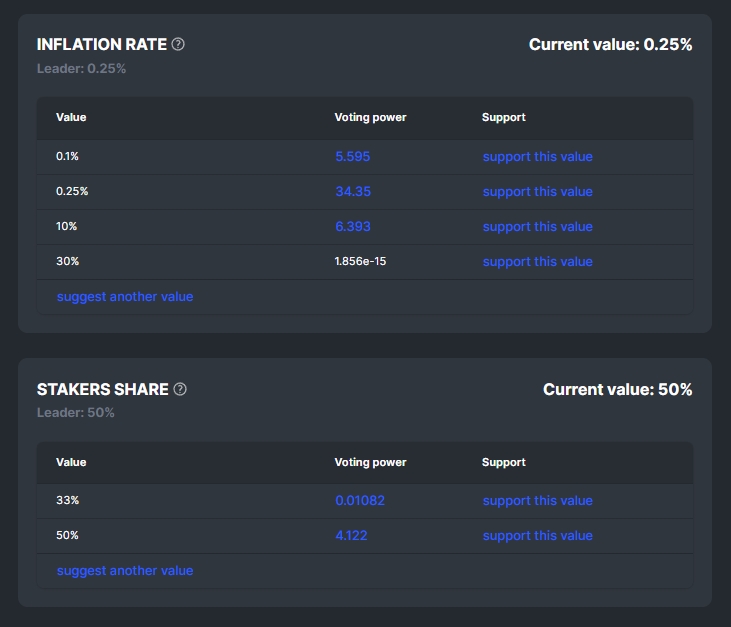Decentralized Exchanges (DEXes) like Oswap.io in Obyte have a great advantage over centralized ones: its own community can decide the trading parameters and the direction they want for the platform to take in the future. This process is called “governance,” and anyone who becomes a Liquidity Provider (LP) can participate with their own suggestions and funds. This way, the exchange and its liquidity pools are really free and controlled by its main stakeholders.
Utilizing a “constant product market maker” mechanism, Oswap.io operates without the traditional order book system. Instead, it relies on liquidity reserves managed by Autonomous Agents (AAs) and provided by the users that willingly become LPs. Through this setup, transactions occur directly against these reserves, with prices automatically adjusted to ensure market equilibrium.
Currently, Oswap.io provides access to 32 pools (fund reserves), encompassing pairs like GBYTE-ETH, GBYTE-WBTC, GBYTE-USDC, GBYTE-BNB, and GBYTE-MATIC. Within these pools, Obyte users can serve as liquidity providers and earn rewards, or simply exchange between different coins. Transaction fees typically range between 0.1% and 0.5%, varying depending on the specific pool.
Another option for users is, of course, to participate in governance. Liquidity Providers can suggest new changes in the parameters themselves or vote to approve or reject those changes. Now, we’re gonna learn how to exactly do that.
Pools and Parameters
First of all, we’ll need to check the pools and the parameters. Governance doesn’t apply to Oswap.io as a whole, instead every pool has its own parameters and governance options, and they need to be voted on and adjusted separately. The parameters that could be potentially changed by voting are available in the “Show All Details” section of the selected pool.
- Swap fee: a percentage per traded amount.
- Exit fee: applied to liquidity providers. It’s a percentage fee applied to withdrawals of liquidity.
- Arbitrageur tax: this is an additional fee applied to arbitrager profit, assuming people buy an asset in the pool specifically to sell it elsewhere (or vice versa) and make a profit from that trade.
- Leverage profit tax: a percentage taken from profits made from leverage trading.
- Leverage token tax: a percentage of the redeemed amount charged when redeeming a leveraged token.
- Base interest rate: applied to leveraged positions, it’s the minimal cost of borrowing those funds.
- Utilization ratio: the share of the pool’s available capacity used for borrowing.
- Actual interest rate: interest rate paid by borrowers. It is equal to the base interest rate when utilization is 0 and grows with growing utilization.
- Borrowed amounts: the total amounts in every token borrowed by leverage traders.
- Return on capital from lending alone: estimated earnings for providing funds to the borrowers in that pool.
- Token weights: it’s the proportion of each token in the pool.
- Pool leverage: it’s a measure of how much capital is assumed available for trading relative to the actual value of the assets held in the pool.
- Price range: it refers to the range of prices at which assets can be traded within the pool.
- LP shares symbol: LP shares represent ownership of certain assets in the liquidity pool. This is the abbreviation or symbol of their token.
Suggesting Changes
If you’re aiming to add better parameters for a specific pool, or even create a brand-new pool, you’ll need to connect your wallet (Login) in Oswap.io first. Then, in the tab “Pools,” you’ll select the pool you want to make suggestions to. Click “Show All Details” and below all the parameters you can see an option “Change these parameters in governance” which links to the Oswap governance website.
Once there, you need to select your voting Obyte address and suggest different values for the items you’re interested in. To vote for the change of every parameter it is necessary to temporarily deposit the LP tokens received by LPs when they provided liquidity into a pool. You’ll decide what amount to deposit for that vote (the larger the amount, the larger the voting power). After voting, you can recover those LP tokens.
The transaction must be confirmed from your wallet, and the funds will be locked (not available for withdrawals) within the governance Autonomous Agent (AA) during a 10-day challenging period. In those 10 days, other traders can vote too to challenge or support your suggestion. If your suggestion eventually wins, your LP tokens will be locked for another 30 days of “freeze period”.
Besides, there is a Discord bot that watches all governance votes and sends notifications to the #DeFi-Governance channel of the Obyte discord server.
Staking OSWAP Token
Another way to participate in governance, and also earn rewards for it, is with the OSWAP Token. This asset was issued on a bonding curve that ensures always available liquidity and has its own website and pools for trading, liquidity mining, and governance.
Users can stake their holdings in OSWAP tokens to get long-term rewards and deposit their LP tokens to receive a share of OSWAP emissions. By locking any amount of OSWAP tokens between 14 days and 4 years, anyone would be entitled to receive emissions of new OSWAP tokens (0.125% per year) and vote for changes to the token’s parameters and distribution rules. In this case, the voting power increases with larger locking periods.
In the menu “Governance” there are four sections: Governance, Stake & Vote, Pool Whitelist, and Params. The first one is an overview of your account’s involvement in the governance, including data like locked balance, unclaimed rewards, voting power, and staking annual percentage yield (APY).
The second section is to select the terms of your participation, including the amount to lock, voting power (VP) distribution among pools, and the locking period. Within the same menu, it’s possible to unstake, withdraw rewards, and move your votes. “Pool whitelist,” as the name suggests, works as a section to vote for adding or removing pools eligible to receive rewards in OSWAP Tokens.
Parameters in OSWAP Token
The OSWAP Token has its own parameters to vote in governance. The meaning of the swap fee and the arbitrageur tax parameters is the same as that of similar parameters in the governance of Oswap.io pools. The other parameters are:
Base appreciation rate: refers to the yearly increase in value of the OSWAP token when the total value locked (TVL) across all Oswap pools matches a predefined base level. If the current TVL deviates from this base level, the appreciation rate adjusts accordingly, scaling proportionally to reflect the disparity.
Inflation rate: this figure represents the annual increase in the supply of OSWAP tokens, resulting from the issuance of new tokens to liquidity providers (LPs) and governance participants, also known as stakers.
Stakers share: it refers to the portion of newly created tokens allocated to stakers who lock their OSWAP tokens in governance. The remaining portion is distributed to LPs who deposit the LP tokens of the incentivized pools.
Base TVL: it represents the total value locked (TVL) across all Oswap pools, which results in the OSWAP token appreciating at the Base Appreciation Rate.
Oracle: this is the specific Obyte data address responsible for monitoring and regularly publishing the OSWAP Token TVL across all Oswap pools.
Challenging period: it serves as the timeframe for most governance decisions in Oswap. When a governance proposal remains unchallenged by any competing proposal within this period, it’s considered accepted. However, two types of governance decisions diverge from this norm: altering the challenging period itself and allocating a portion of reserves to a management team for Oswap promotion. These decisions require a majority approval rather than being decided solely by the absence of challenges.
This is the last section of the Governance tab on the OSWAP Token website. The menu shows not only the available params, but also its current values, previous votes with voting power, and the option to suggest another value. After a challenging period of five days, a new proposal is considered accepted and can be enabled (committed) by anyone.
Let’s remember that participating in governance in DEXes like Oswap.io is crucial as it empowers LPs to shape the direction and policies of the platform. This involvement ensures transparency and decentralization, ultimately fostering a more inclusive and robust financial ecosystem. Ready to participate yourself?
Featured Vector Image by storyset / Freepik



